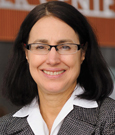Although many oncologists consider matched sibling donors as the best source of grafts for hematopoietic cell transplantation, two separate studies presented at the recent American Society of Hematology Annual Meeting support the use of alternative donor grafts for patients with lymphoma and acute myelogenous leukemia (AML).1,2 Additionally, the studies show that older patients with hematologic malignancies can safely undergo transplantation using these alternative donor sources.
“Many practicing oncologists have not shifted their criteria for referring patients for transplant. Patients can benefit from allogeneic transplants even if they don’t have a matched family member and this includes older patients, but many in the community have not kept pace with newer data,” stated Mary M. Horowitz, MD, MS, Professor of Medicine, Robert A. Uihlein, Jr Chair in Hematologic Research, and Chief, Division of Hematology and Oncology at the Medical College of Wisconsin, Milwaukee.
Lymphoma Study
The first study included 1,593 non-Hodgkin and Hodgkin lymphoma patients with no age restriction (ages ranged from 17 to 73 years) who underwent donor hematopoietic cell transplantation with alternative donor grafts from one of three different sources: umbilical cord blood (n = 142), 8/8 HLA-matched unrelated donor (“well matched,” n = 1,176), and 7/8 matched unrelated donor (“partial matched,” n = 275). Outcomes from 2000 to 2010 were compared as reported to the Center for International Blood and Marrow Transplant Research.
“Our results suggest that umbilical cord blood and 7/8 unrelated donor grafts provide similar survival to 8/8 unrelated donor grafts. This extends allogeneic hematopoietic cell transplantation to most patients with no suitable matched sibling donors,” stated lead author Veronika Bachanova, MD, PhD, Assistant Professor of Medicine, Division of Hematology, Oncology and Transplantation, at the University of Minnesota, Minneapolis. She said that determining graft source depends on availability, the urgency of transplant, and transplant center experience.
In this study, one-third of patients are alive beyond 2 years. These are patients who have shown disease progression on early therapies, and half of them had prior autologous stem cell transplantation. They all underwent transplant with a nonfamily donor. They were chosen for transplantation because they are still responsive to therapy and are in suitable physical condition.
Leukemia Study
The second study included 740 AML adults over age 50 in first complete remission and compared the effectiveness of the same three nonfamily donor sources in achieving a successful transplant: umbilical cord blood (n = 205), 7/8 HLA matched (n = 94), and 8/8 HLA matched (n = 441). Outcomes were reported to the Center for International Blood and Marrow Transplant Research on transplants performed from 2005 to 2010. Median age was 58 years, and ages ranged from 50 to 75 years.
Median follow-up was 50 months in the well-matched group, 61 in the partial matched group, and 37 months in the umbilical cord donor group. Neutrophil and platelet recovery was slower in the latter group compared with the other two groups. The incidence of neutrophil recovery in the umbilical cord group was 85% on day 42 compared with 98% in the well-matched group and 92% in the partial matched group.
No significant differences between the three groups were seen in grades II to IV acute graft-vs-host disease; the 3-year incidence of chronic graft-vs-host disease was significantly lower with umbilical cord transplant (28% vs 53% and 58%, respectively).
Leukemia-free survival for all three donor groups was between 30% and 43% at 3 years. Relapse risk was greatest in patients with unfavorable cytogenetics regardless of graft type; overall survival was worse in these patients as well as in those over age 60.
Expanded Pool of Donors
“Both studies found that umbilical cord blood was about as good as either of the unrelated donor graft sources. In the lymphoma study, all endpoints except engraftment were similar with all three sources, including toxicities, relapse, and survival. In the AML study, which was focused on one disease and had more restrictive criteria for older age and disease status, the partial matched and umbilical cord transplants were about the same, but the fully matched patients did better,” said Daniel Weisdorf, MD, Professor of Medicine at University of Minnesota, Minneapolis. Dr. Weisdorf was lead author of the AML study and coauthor of the lymphoma study.
Both studies show that donor source is not a limitation for transplant and that older age per se should not preclude transplant, he emphasized.
When asked which donor source was preferable, he said: “This is not a horse race. We are not offering the same treatment to the same person. We are saying there are several different and suitable options for people who do not have a family donor. Matched sibling donor is the first choice, but we have shown that in two major diseases where transplantation is performed with substantial frequency, we now have three choices. All of them are good, and post-transplant survivals are similar.”
AML is mainly a disease of people over age 50. “Now we can be comfortable looking at an expanded pool of donors for people with lymphoma and AML who need transplant, whether unrelated adult volunteers or umbilical cord donors for people with AML,” Dr. Weisdorf said. “There is reason to believe that this would be the case for people with acute lymphoblastic leukemia as well,” he added.
Option for Older Patients
“Transplant physicians and referring hematology physicians have been reluctant to consider transplant as an option for older patients. Transplantation should be considered for older patients whose disease justifies it and who don’t have an available family donor,” he emphasized.
“We and other investigators have done a number of studies to demonstrate that older patients with AML or myelodysplastic syndrome have encouraging outcomes [after transplantation]. A birth date does not predict survival. Overall fitness, lack of comorbidities, and willingness to undergo intensive therapies should determine transplant,” he emphasized.
Shedding Preconceptions
Agreeing with Dr. Weisdorf, Dr. Horowitz emphasized the importance of referring older patients and patients without a matched related donor for transplant. “The 5-year survival of older patients with AML on chemotherapy is less than 10%. Previous data show that the outcome of unrelated donor transplant with a limited degree of mismatching is similar to related matched transplant. Survival of older adults with AML who undergo transplantation is about 30% at 5 years,” she said.
“Physicians have to drop their preconceived notions of age < 50 for allogeneic transplant and matched sibling as donor source. We can find a donor for almost any patient, and older patients who might benefit from transplant should be referred as soon as possible to ensure that the procedure is done at a point in their disease when the likelihood of success is highest,” she added. ■
Disclosure: Drs. Horowitz, Bachanova, and Weisdorf reported no potential conflicts of interest.
References
1. Bachanova V, Brunstein C, Burns LJ, et al: Alternative donor transplantation for adults with lymphoma: Comparison of umbilical cord blood vs 8/8 HLA-matched donor (URD) vs 7/8 URD. ASH Annual Meeting. Abstract 161. Presented December 8, 2013.
2. Weisdorf D, Eapen M, Ruggieri A, et al: Alternative donor hematopoietic transplantation for patients older than 50 years with AML in first complete remission: Unrelated donor and umbilical cord blood transplantation outcomes. ASH Annual Meeting. Abstract 302. Presented December 9, 2013.




